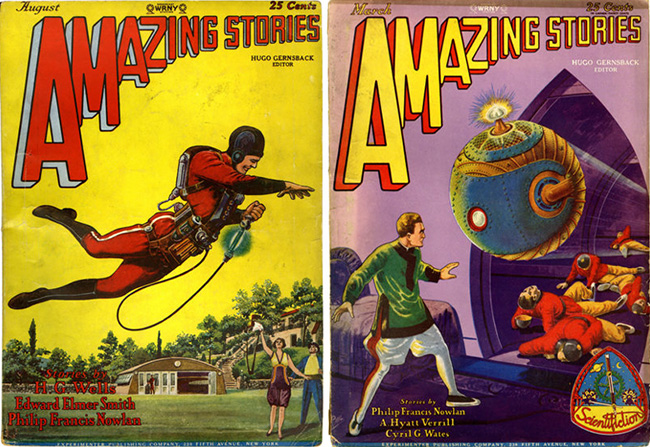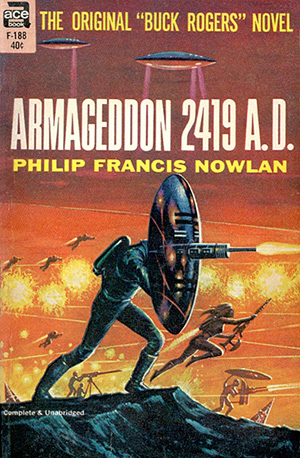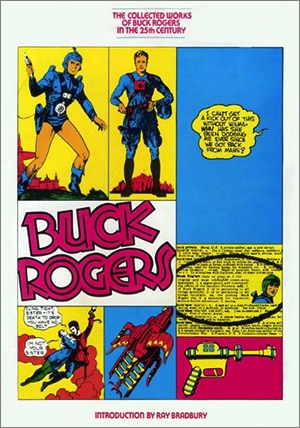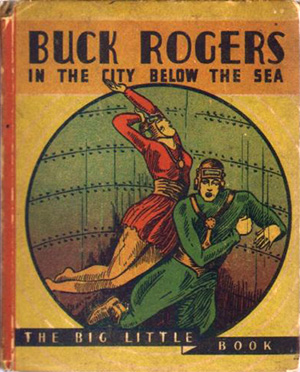In this bi-weekly series reviewing classic science fiction and fantasy books, Alan Brown looks at the front lines and frontiers of the field; books about soldiers and spacers, scientists and engineers, explorers and adventurers. Stories full of what Shakespeare used to refer to as “alarums and excursions”: battles, chases, clashes, and the stuff of excitement.
When we think about stories that brought science fiction to the attention of mass audiences, today we tend to think immediately of Star Wars. For decades before George Lucas brought his creation to the big screen, however, there was one character who stood at center stage: Anthony “Buck” Rogers. Because Buck has visited us in so many forms over the years, I’m going to look at three different works today. The first is Armageddon 2419 A.D. by Philip Francis Nowlan, a book combining the two novelettes from Amazing Stories that first introduced the character. Second is The Collected Works of Buck Rogers in the 25th Century, a selection of Buck Rogers newspaper comics from over the years, with a wonderful introduction by Ray Bradbury. And the third is a family heirloom, a “Big Little Book” that I inherited from my father: Buck Rogers in the City Below the Sea.
My dad was born in 1922, and grew up in the suburbs of New York City, a metropolis with one foot in the future. His father worked at Bell Labs, and he remembered being taken to work to see new inventions like the first televisions. His father also, in the wee hours of one morning in 1927, took him to Roosevelt Field so he could watch Charles Lindbergh take off on the first non-stop solo flight from New York to Paris. He watched the construction of the world’s highest skyscraper, the Chrysler Building, followed shortly by a new highest skyscraper, the Empire State Building. The city was criss-crossed by an ever-expanding network of mass transit, with new aircraft flying to the growing airports, and all manner of new ships plying the waters. Even after the Crash of 1929, New York City continued to be a center for technological innovation, culminating in the New York World’s Fair of 1939, which promised attendees a look at the world of tomorrow. It’s no wonder that my dad took to Buck Rogers like a duck to water when the strip appeared in the newspaper. He often talked about how much he enjoyed the comic strip, and how it inspired his life-long love of science fiction. And my dad was not alone—all over the country, youngsters couldn’t get enough of Buck Rogers and his adventures.
About the Creators
Philip Francis Nowlan (1888-1940) was a newspaper columnist who also wrote science fiction stories. He brought one of these stories to the National Newspaper Syndicate, which was looking for ideas for a daily adventure comic strip…and from this small beginning came the work of a lifetime.
John F. Dille (1884-1957) was the founder of the National Newspaper Syndicate, which operated from 1917 to 1984. The most notable comic syndicated by the company was Buck Rogers in the 25th Century A.D., running from 1929 to 1967. Dille paired writer Philip Nowlan with artist Dick Calkins, which proved to be a winning combination.
Dick Calkins (1894-1962) was a newspaper cartoonist who served as a flight instructor for the U.S. Army in World War I. He was an editorial cartoonist before being asked to draw the Buck Rogers comic strip in 1929.
Because they have gone out of copyright, the original novelette, “Armageddon 2419,” is available for reading at Project Gutenberg, as is its sequel “The Airlords of Han.”
Armageddon 2419
The version I read for this review is a fix-up of the two aforementioned novelettes that originally appeared in Amazing Stories, “Armageddon 2419” and “The Airlords of Han.” The two were first combined into a single novel the 1960s by Donald A. Wollheim. The book was then re-edited by Spider Robinson, and released by Ace Books in 1978. While I haven’t compared the Spider Robinson version with the original magazine version extensively, it appears that he updated and streamlined the prose, and also removed the racist overtones that characterized the original works. The origin of Buck Rogers is, unfortunately, rooted in a tale that describes the conquering of the world by a people referred to alternately as “Mongols,” or the “Han.” This setting evoked the racist ideology behind the “Yellow Peril,” which argued that Asian people were a threat to Western civilization. Like many other characters that originated in the early 20th century, Buck Rogers would be reinvented over the years to mitigate such unpleasant and outdated elements of the original tales.
In the first novelette, World War I Army Air Corps veteran and engineer Anthony Rogers is sent to investigate a mine, is trapped by a cave-in, succumbs to a mysterious gas, and enters a state of suspended animation. He awakens when the rocks shift, allowing fresh air into the cavern. He emerges to find a young woman being attacked and, when she is injured, uses her rocket pistol on her attackers. The woman, Wilma, tells him it is the 25th century, and that during the 22nd century, America, like most of the rest of the world, fell under the domination of the Han. Using advanced technology like aircraft lifted on repulsor beams and disintegrator ray-guns, they have laid the United States to waste. The population is now organized into gangs who live a nomadic life, hiding from the Han. Wilma helps Rogers take a jumper belt from a dead attacker, which uses a substance called “inertron” that reacts to gravity in a manner opposite to normal matter. Wilma’s attackers were Americans called Bad Bloods—bandits who attack other gangs, and sometimes cooperate with the Han.
Rogers joins Wilma’s gang, and after convincing the leaders that his story of a long hibernation is true, uses his experiences in the 20th century to develop new tactics that help them fight the Bad Bloods. In addition to inertron, the Americans have developed ultron, a substance that can be used in radios, enabling them to transmit in ways undetectable by normal radios. Ultron also can be used to build shields impervious to Han disintegration beams. Rogers stumbles on a way to use rocket shells to disrupt repulsor rays, and brings down a Han airship. The Americans have been on the verge of rising up against the Han, and this action is the catalyst for widespread action, with Han airships downed all over the country. There is an American gang betraying their secrets to the Han, however, and soon Rogers and Wilma are on a daring raid into the Han headquarters in what used to be New York City in order to find the secret of the betrayers in their records. When that information is discovered, a coalition of gangs moves on the gang that betrayed them, and their defeat puts the Americans on the road toward freedom. This first novelette is packed with action only occasionally punctuated by exposition about the new world Rogers has landed in, and is a fun read.
The second novelette that makes up this short novel begins when the Han occupation is collapsing. The Americans have developed swoopers, flying vehicles shielded against disintegration rays, but the Han have developed ground ships that float just above the grounds, and function like 20th-century tanks. After participating in a couple of battles where innovations on both sides are pitted against the other, Rogers crashes in a damaged swooper and is captured by the Han and taken to their capital. This sucks the life out of the narrative, as the war for independence is then viewed secondhand by Rogers as a prisoner. Moreover, the text focuses far too much attention on the inferiority of the decadent Han culture, as compared to the strength and vitality of the Americans. Even edited to remove the overtly racist statements, this narrative is unpleasant to read. Rogers is finally rescued by floating American robot drones and escapes to be reunited with Wilma. The end of this war of independence brings the second novelette, and the novel, to a close.
The Collected Works of Buck Rogers in the 25th Century
This coffee table book was assembled in 1969, just after the first moon landing, and starts off with an affectionate introduction from Ray Bradbury. He recounts his love for Buck Rogers, describing how all across the country, the character introduced youngsters to an exciting future, full of possibilities. The collection includes a selection of story arcs from throughout the first few decades of the comic strip. One change from the original tales in Amazing Stories was the decision that “Buck” was a catchier first name for the character than “Anthony,” which clearly turned out to be a wise choice.
The artwork of Dick Calkins gets some criticism, as it is frequently rather primitive looking, and the characters are often awkwardly posed. The panels have a lot of text, and are packed with odd little details. But the artwork is also very much of its time, and Calkin had the challenge of drawing devices, vehicles, and costumes that had no analog in the real world. For many years, when people thought of the future, they imagined it in the context of Calkins’ artwork.
The first couple of years of the comic strip loosely followed Nowlan’s original two novelettes from Amazing Stories, with Buck traveling around the United States to drive out the Han invaders. Reportedly, the syndicate used the mention of specific cities visited by Buck to encourage additional newspapers to pick up the strip in syndication. There are a lot of romantic subplots and misunderstandings between Buck and Wilma; the strip even introduces an old boyfriend, Killer Kane, who is so enraged by Wilma picking Buck over him that he turns traitor, and begins to help the Han invaders. He is such a despicable figure, you wonder what Wilma saw in him in the first place…
It was after the Han were defeated, however, that the series really reached its full potential. As it recovers from the Han occupation, the society explodes with new inventions, and soon Buck is rocketing off to other planets. He faces alien invasions, battles on the moon, encounters with the Tiger-Men of Mars, the discovery of sunken Atlantis, and travels to Jupiter and even Planet X (where World War II-era anti-Japanese racism unfortunately rears its ugly head).
The Sunday comic strips, because some people did not read both daily and weekly papers, presented separate adventures, often featuring Bucky Deering, Wilma’s younger brother, and his friend Alura. These strips presented the future in bold and vibrant colors.
Today, completists can find every Buck Rogers strip available in multi-volume collections, but this particular collection gives you a good cross-section of the tales in a single book.
Buck Rogers in the City Below the Sea
This book, containing a story drawn from the daily newspaper strips, was published in 1934, when my dad was 12. It was one of his prized possessions, one of the few childhood mementos he kept throughout his life, and was my own first introduction into the world of Buck Rogers. The Big Little Books were created by Whitman Publishing in 1932, and were small, thick books that contained stories presented with prose on one page with an illustration on the facing page. The books were aimed at children and primarily featured characters from comics or films. They were published until the 1960s.
This book closely follows the comic strip, although it is heavily abridged, and uses artwork drawn from the strip. It follows Buck and Wilma as they investigate the appearance of mysterious albinos around the world. One of these has had her memory scanned by scientists who discover that she lived in an undersea city and had the ability to remain underwater without breathing for extended periods of time. Buck and Wilma report to a flying submarine that has been assigned to them to find it has already departed. Their longtime enemy Killer Kane has wooed the young Lieutenant Ardala Valmar and convinced her to betray her superiors. Buck and Wilma find the submarine, and they believe Ardala when she says their departure was a mistake. Buck survives a shark attack, and finds the undersea city of Atlantis. Killer Kane and his piratical minions capture the submarine, but Wilma escapes. Buck and Wilma are reunited, and meet Atlanteans who greet them warmly, but say they can never leave because the existence of Atlantis must remain secret from the outside world. Then Killer Kane and Ardala arrive and try to convince the Atlanteans that Buck and Wilma are the pirates. There are many twists and turns as Kane and Ardala prove to be crafty opponents, but finally Buck and Wilma regain their submarine, befriend the Atlanteans, and head back to the surface world with an offer of trade. The plot is overly contrived, but moves at a brisk pace, with lots of action. As a youngster, this was my first exposure to the legend of Atlantis, and I found the concept of a lost world fascinating. To my father’s dismay, we loved the book so much it began to come apart at the seams.
Buck Rogers in Other Media
People today might wonder how a comic strip character could have such broad and extensive popular appeal, but you have to remember that in the day, syndicated comics were a major form of entertainment. There was no TV or internet, and other than records that only played a song or two at a time, there was no recorded media to consume at home, other than books or periodicals. And over the years, of course, Buck appeared in a lot of other formats as well. I won’t include all the incarnations of Buck Rogers here, but will mention some of the highlights:
The Buck Rogers strip spawned all sorts of related merchandise, including ray guns, rocket pistols, spaceships, and other toys. There was a popular radio show that ran for a number of years. The series spawned a 1939 movie serial that started Buster Crabbe. There were also appearances in comic books.
Buy the Book
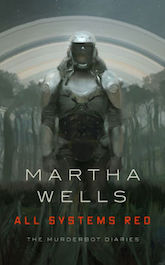

All Systems Red: The Murderbot Diaries
The character garnered renewed interest in 1979 when producer Glen Larson, coming off success with the Battlestar Galactica TV show, led efforts to create a TV show featuring Buck Rogers. Gil Gerard starred as Buck and Erin Grey played Wilma. The pilot was well received, and actually gained a theatrical release. After a first season with disappointing ratings (perhaps because the tone was too campy), the series was retooled to focus on deep space exploration. But the retooling did not turn things around, and the show ended after a second season. The show was my son’s first exposure to Buck Rogers, and his favorite character, Twiki the robot, was his first action figure.
In the late 1980s, TSR (the company that brought the world Dungeons & Dragons) launched a multi-media effort featuring Buck, called “Buck Rogers XXVC.” This involved novelizations, comic books, video games, role-playing games, and a board game called “Battle for the 25th Century.” That game, which my son and I often played, involved a battle for control of the solar system. While it quickly settled into a stalemate with two players, it also generated epic space battles that kept us entertained for hours.
Buck and Wilma have never gotten the big-budget movie screen incarnation they really deserve, but like many fans, I still have hopes. The financial failure of the John Carter movie a few years ago has probably dimmed the chances of many projects involving classic SF characters, but there is always talk among the fandom. I would love the character to receive the kind of treatment director Joe Johnston gave The Rocketeer and Captain America: The First Avenger.
Final Thoughts
So, there you have it, a quick overview of the many adventures of Buck Rogers and Wilma Deering, characters I’ve loved for years. Buck has been quiet recently, but his influence on the field of science fiction has been huge, and I wouldn’t be surprised to see him making more appearances in the future.
And now, you have the floor. Have you read any of the books I’ve mentioned in the column, and if so, what did you think? What incarnations of the character introduced you to Buck, and which did you enjoy the most? And what new versions might you want to see going forward?
Alan Brown has been a science fiction fan for over five decades, especially fiction that deals with science, military matters, exploration and adventure.










